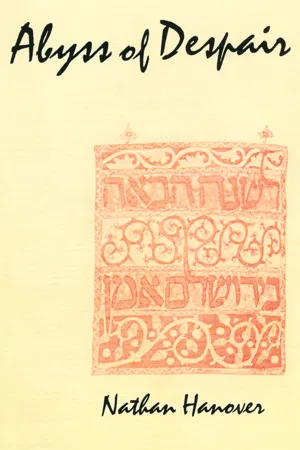
- 150 pages
- English
- ePUB (mobile friendly)
- Available on iOS & Android
Abyss of Despair
About This Book
Providing a gripping, first-hand account of the Chmielnicki massacres in 1648-58, in which tens of thousands of Jews perished in Poland and the Ukraine, Rabbi Nathan Hanover describes the events themselves and their effect on European Jewry. Hanover's description of the atrocities commited* by Chmielnicki and his hordes makes it clear that they set the precedent for Hitler's torture chambers. Hanover's account of the events understood in their historical context 'shows how humans can transcend tragedy and rebuild their lives, developing new ways to express their heritage and culture. Professor Helmreich, in his new introduction, describes the- period of relative peace and prosperity for the Jews immediately preceding the massacres. He traces some of the important effects the massacre had on later Jewish history, such as the rise of Messianic and Hasidic movements in the seventeenth and eighteenth centuries and the migration of Jews back toward the west, where they were situated when the Enlightenment swept through Europe.
Frequently asked questions
NOTES TO TRANSLATOR’S INTRODUCTION
AUTHOR’S INTRODUCTION
Table of contents
- Cover
- Half Title
- Title Page
- Copyright Page
- Contents
- Illustrations
- Translator’s Note
- Foreword to the Transaction Edition
- Translator’s Introduction
- The Life and Work of Nathan Hanover
- Author’s Introduction
- I. Abyss of Despair
- II. The Massacres of Nalevaiko
- III. The Massacres of Pawliuk
- IV. The Brutal Oppressions of Chmiel
- V. The Massacres of Nemirow
- VI. The Massacres of Tulczyn
- VII. The Massacres by Polannoe
- VIII. The Massacres of Ostrog and Zaslaw
- IX. The Massacres of Konstantynow
- X. The Massacres of Lithuania
- XI. The Massacres of Bar
- XII. The Massacres of Lwow
- XIII. The Massacres of Narol
- XIV. The Massacres of Zamosc
- XV. The Second Massacre of Ostrog
- XVI. The Inner Life of the Jews in the Kingdom of Poland
- XVII. Notes